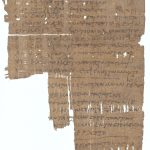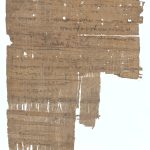| Artefact ID | 1461 |
| TM ID | TM 68620 |
| Findspot (DEChriM ID) | - () | Class | Textual |
| Material | Papyrus |
| Writing medium | Uncertain |
| Text content | Subliterary |
| Language | Greek |
| Description | P.Berl. 17202: Fragment of a magical spell collection |
| Selection criteria | Subliterary genre (Liturgical), Christian terms/formulas/concepts, Nomina sacra |
| Date from | 300 |
| Date to | 399 |
| Dating criteria | Palaeography; the ed.pr. points out a “practiced but hurried style typical of documentary hands”. The variation in writing by a single hand (multiple writing instruments and varying inks) implies the spell recipes were copied over a period of time. The ed.pr. notes the spells may have been derived from other sourcebooks or various amulets. |
| Absolute/relative date | Relative date |
| Archaeological context | Unknown provenance. |
| Accession number | Berlin, Staatliche Museen, Ägyptisches Museum und Papyrussammlung P. 17202 |


 Json data
Json data





